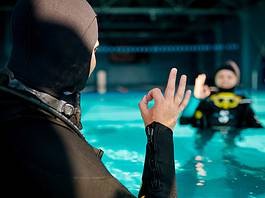On my first Red Sea dive, the divemaster suggested that I needed 8-10 kg in weight, to which I snorted, implying that he was sorely mistaken, oh how wrong was I! In order for the divemaster to assess that I was as good at diving as I had implied, we began with a shallow shore dive. I ungraciously took extra weight as recommended – 6kg, two whole kilos more then normal. Embarrassingly the descent was very tricky and I began to wish I had listened and brought more weight! Needless to say, it was an uncomfortable dive and I learned my lesson.
So what is buoyancy?
Legend holds it that Archimedes suddenly realized the principle of buoyancy while watching his bath water overflow, delighted at his discovery, he ran home without his clothes, shouting "Eureka"! A diver is subject to Archimedes Principle, which states that ‘an object floats if it weighs less that the amount of water it displaces’. For example if a diver weighs 70kg but displaces 71kg (71 litres) of salt water, they will float, to get neutrally buoyant they need to add 1kg of weight to their weight belt! A penny thrown in the water will sink because the density of metal is much greater than that of water. However, a steel ship will float because, the effective volume of the ship includes all the air inside it, so that its average density is then less than that of water.
In layman’s terms, a diver needs to be able to achieve the three states of buoyancy throughout a dive, positive, neutral and negative. To descend at the beginning of a dive we need to be negative, to swim smoothly in mid water during the dive we need to be neutral and to be comfortable at the surface at the end of the dive we need to be positively buoyant!
Why is buoyancy important to divers?
Buoyancy is one of the most important skills to learn in diving; to become a better diver, to streamline your body, to conserve air thereby gaining longer bottom times, to move naturally amongst the local marine life avoiding injury and more importantly to avoid crashing thorough and damaging the reef. Photographers need it to take good photographs safely, there is nothing worse then watching a photographer crushing corals under their knees to take that perfect shot! Cave divers need buoyancy to be able to move along passageways without disturbing the bottom sediment, or the person following will see nothing but clouds of sand.
What affects our buoyancy?
There are so many factors to consider when diving in a new place; is it salt water or fresh, have I put on, lost weight since my last dive, is my wetsuit thicker, or thinner, is my tank steel or aluminium, am I calm or excited? All these things affect our buoyancy.
The reason for my faux pas in the Red Sea was that unknown to me it is one of the saltiest seas on the planet, due to its high rates of evaporation. Therefore, in general, a warm climate means saltier sea and the saltier sea means the more buoyant we are going to be. Think of how people are able to float on the top of the water in the Dead Sea, which has 5 times the normal content of salt. Fresh water means no salt and therefore less buoyant, so less weight needed.
Fat is positive! Each person has a different body makeup and as such will have different buoyancy issues. In general a person that finds it easy to float on the surface of the water, is naturally ‘positively buoyant’ and probably a little on the chubby side. A lean, mean athlete will sink like a stone because muscle is negative!
With lungs, size matters. When my little brother (all 6ft 4in of him) did his open water, his 8ltr lung volume seriously affected his diving. When he fully fills his lungs in shallow water, he rises very quickly which means he has to control his breathing to ensure stability. By breathing slow, long, and remaining calm, a diver will maintain far better buoyancy and use less air, making for a longer dive.
Wetsuits trap small bubbles of air within the neoprene so the thicker the wetsuit, the more air trapped, causing the diver to be more buoyant. A 3mm shorty will have very little effect, however a 7mm long john and jacket will need a lot of counterbalancing with weights. The trapped air in a Dry Suit expands and contracts as you descend and ascend and like a BCD, it is necessary for the wearer to control this air. If the air in a dry suit remains unchecked on an ascent for example, it will expand making the divers ascent go rapidly out of control, which is why it is a good idea to try a Dry Suit for the first time in confined conditions.
The size and metal of the tank is another factor. Steel tanks are heavier then aluminium, which can be an advantage when you need more weighting. A full aluminum tank is also heavier then an empty one, therefore, the tank will gradually become more positively buoyant during the dive, making the diver more postively buoyant at the end of the dive.
At 30m, it is fairly easy to maintain a sleek dive profile because a slight dip or rise in the profile will have little affect on trapped air in your BCD or suit. Diving at 5m is a little trickier because air will expand more rapidly due to the greater pressure changes in shallow water. This is why divers, who have had perfect buoyancy through out a dive, can experience huge difficulties at the safety stop.
How to realise good buoyancy.
Do the surface buoyancy test before the dive (all organizations teach this at the open water level), this is a good rule of thumb to ensure you have the correct amount of weight. Overweighting is a common problem with inexperienced divers. A diver with too much weight will end up working much harder to move through the water because, drag is created due to putting extra air in the BCD, which involves more air consumption and therefore less bottom time. Otherwise, the diver will swim with head high and feet low and probably in a bicycling motion, kicking up bottom sediment. Correct weighting will help streamlining, air consumption and general diving comfort.
I strongly recommend everyone to take a buoyancy class, where good weighting, streamlining and proper breath control are taught. A diver should know how to glide smoothly through the water.
Conclusion
Every diver has an obligation to learn good buoyancy control, it is the essence of what being a good diver is all about, it is what makes a diver look very slick and move naturally through the water, it truly reveals a divers skill. Mastering buoyancy gives divers the chance to stop thinking about how to dive, so they can concentrate on the beauty surrounding them, but more then that, the experience of feeling weightlessness is the ultimate relaxation!


